

 |
 |
ALFRED ROGOWAY - 1900-1990
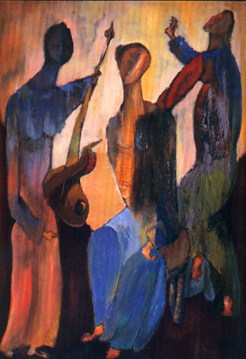 A Somnambulist Who Dreams in Paint
A Somnambulist Who Dreams in Paint
by Kaya Morgan
 Using scenes from his own inner consciousness, Alfred Rogoway created a world of sensitively distorted figures. His beings are fairy tale creatures and from myths that partake of all the activities of man in a mood which might be termed eternal. A true somnambulist who dreams in paint, finding expression for all the subtleties of his nature on canvasses. He prays, dances, loves and plays in rich vibrant colors and delicate, delineated drawing. Rogoway always wished to create something truly beautiful so that the world would have gained through his expressions of life.
Using scenes from his own inner consciousness, Alfred Rogoway created a world of sensitively distorted figures. His beings are fairy tale creatures and from myths that partake of all the activities of man in a mood which might be termed eternal. A true somnambulist who dreams in paint, finding expression for all the subtleties of his nature on canvasses. He prays, dances, loves and plays in rich vibrant colors and delicate, delineated drawing. Rogoway always wished to create something truly beautiful so that the world would have gained through his expressions of life.
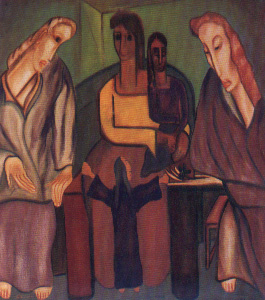 At the turn of the century, Alfred Rogoway was born in Portland, Oregon, the youngest of three children of a well known playwright father and artist mother. Upon his father's untimely death when he was just five years old, his mother took young Alfred under her wing as she retreated into the world of her painting. Although he spent many long hours observing her relentless application of colors and was thoroughly intrigued by the process, Alfred was initially drawn to music where for five years he played trombone and led a five piece jazz band.
At the turn of the century, Alfred Rogoway was born in Portland, Oregon, the youngest of three children of a well known playwright father and artist mother. Upon his father's untimely death when he was just five years old, his mother took young Alfred under her wing as she retreated into the world of her painting. Although he spent many long hours observing her relentless application of colors and was thoroughly intrigued by the process, Alfred was initially drawn to music where for five years he played trombone and led a five piece jazz band.
 During the first World War, Rogoway served as a U.S. Navy, sub-chaser until his ship was finally torpedoed. As one of the few survivors rescued, he was sent home only to find that both his brother and sister had also met their untimely deaths. Provoked by feelings of remorse over his loss, he defiantly chose to express life through the use of vibrant colors. With every stoke of the brush, he punctuated his resolve — cherishing and portraying the full essence of life.
During the first World War, Rogoway served as a U.S. Navy, sub-chaser until his ship was finally torpedoed. As one of the few survivors rescued, he was sent home only to find that both his brother and sister had also met their untimely deaths. Provoked by feelings of remorse over his loss, he defiantly chose to express life through the use of vibrant colors. With every stoke of the brush, he punctuated his resolve — cherishing and portraying the full essence of life.
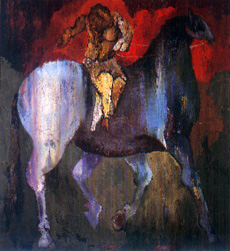
His decision to pursue a formal career in the arts earned him a Masters of Fine Arts degree and Doctorate in Philosophy from the University of California at Berkeley. Later, he was accepted to study under Lyonel Feininger and Fernand Leger at Mills College which led to an introduction and further studies with Jose Orozco at the University of Mexico. Then, for three consecutive years, Rogoway's paintings were selected by the San Francisco Museum of Modern Art's open competition which soon began to generate serious interest from the art world.
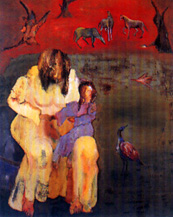 Many artists, sculptors and writers began moving to the new Mecca of Santa Fe, New Mexico in the 1940s and Rogoway was no exception. Gone were the days of jumping a freighter out of the South Pacific and landing in Vancouver, B.C., arrested as a stowaway. The adobe home he settled in on Canyon Road, just beyond the galleries, became the site of many legendary parties! At one such party, he met his future lifetime mate, Marjorie Goldbert. The chemistry was instantaneous between them and within a week they were wed.
Many artists, sculptors and writers began moving to the new Mecca of Santa Fe, New Mexico in the 1940s and Rogoway was no exception. Gone were the days of jumping a freighter out of the South Pacific and landing in Vancouver, B.C., arrested as a stowaway. The adobe home he settled in on Canyon Road, just beyond the galleries, became the site of many legendary parties! At one such party, he met his future lifetime mate, Marjorie Goldbert. The chemistry was instantaneous between them and within a week they were wed.
Deciding to settle into a slower routine, the family moved to Big Sur, California where Alfred met and cajoled with famed author, Henry Miller, who remained a close friend and encouraging supporter for decades. But not long after the birth of their daughter, Esther, in 1947, with baby in arms, the Rogoway family once again boarded a freighter bound for France. It was there that Alfred met and developed a close bond with Pablo Picasso, as they frequently exchanged thoughts and ideas.
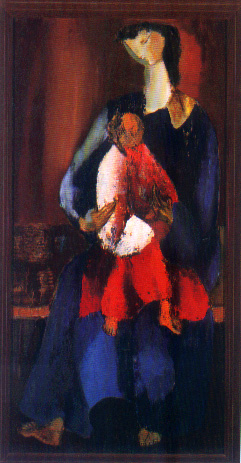 With wanderlust still in his blood, the family once again moved — this time to Ajijic, Mexico where Rogoway finally found himself able to devote full time to his art. He and Marjorie spent many blissful years in Mexico, returning to Taos in the summers to visit with friends. Finally, Alfred realized that to become truly recognized in his field, he must move to where modern art was most idealized.
With wanderlust still in his blood, the family once again moved — this time to Ajijic, Mexico where Rogoway finally found himself able to devote full time to his art. He and Marjorie spent many blissful years in Mexico, returning to Taos in the summers to visit with friends. Finally, Alfred realized that to become truly recognized in his field, he must move to where modern art was most idealized.
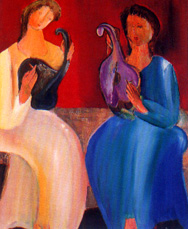 Moving to New York in 1955, they found the city electric with the banter and escapades of other artists already on the scene - William De Kooning, Robert Motherwood, Jackson Pollock, and Clifford Still. Laura Barone had just opened her new gallery on Madison Avenue and Rogoway quickly became her top-selling artist. His work was exhibited at the prestigious Museum of Modern Art along with Braque, Miro, Picasso and other famous artists of the day.
Moving to New York in 1955, they found the city electric with the banter and escapades of other artists already on the scene - William De Kooning, Robert Motherwood, Jackson Pollock, and Clifford Still. Laura Barone had just opened her new gallery on Madison Avenue and Rogoway quickly became her top-selling artist. His work was exhibited at the prestigious Museum of Modern Art along with Braque, Miro, Picasso and other famous artists of the day.
When the family finally purchased a large home in Sag Harbor, Long Island, Marjorie, quickly decided to turn the entire downstairs into a restaurant — soon becoming the hot spot for New York's elite creative types. Although they continued to spend time at their home in Mexico, Alfred's lust for life was once again stirring, and Europe was his next target!
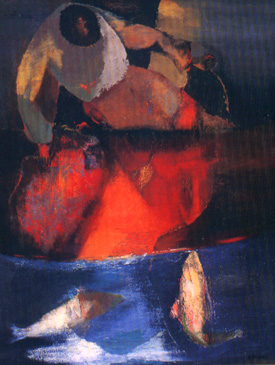 In 1958, the Rogoway's decided to make the Mediterranean their new home, high on a mountain top in Mijas, Spain. Beside the breathtaking views of the azure seas, they entertained in a grand manner with such prestigious guests as the Spanish Minister of Culture, Ingrid Bergman, Robert Shaw and Mary Ure, all of whom purchased his work. Rogoway even had showing at the Grosvenor Gallery in London, becoming a Lifetime Associate, where his work still remains in their permanent collection.
In 1958, the Rogoway's decided to make the Mediterranean their new home, high on a mountain top in Mijas, Spain. Beside the breathtaking views of the azure seas, they entertained in a grand manner with such prestigious guests as the Spanish Minister of Culture, Ingrid Bergman, Robert Shaw and Mary Ure, all of whom purchased his work. Rogoway even had showing at the Grosvenor Gallery in London, becoming a Lifetime Associate, where his work still remains in their permanent collection.
The Rogoway's were on a roll and decided to remain abroad until in 1980 when Marjorie, now 70, was diagnosed with Parkinson's disease. Although the parties did not diminish in grandeur, they did become less frequent. Finally, when Marjorie passed away in 1983, Alfred found he could no longer remain in a place filled with so many memories. At 83, it was time to head home to live with his daughter, Ester, and grandchildren, who had now settled in Tuscon, Arizona. Soon thereafter, Esther, began searching for a gallery to represent her father's work and found Peggy Lanning's gallery in Sedonna, who became Rogoway's exclusive representative.
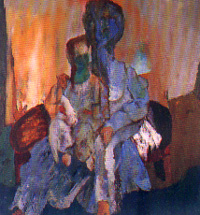
During his final years, Alfred quietly painted in a small studio behind the family house until his death in 1990, while painting. Today, his presence still lives on in permanent collections at the Grosvenor Gallery in London, the Copenhagen National Museum, the American Gallery in Los Angeles, the Universities of Illinois, Arizona, New Mexico and in private collections throughout the world — a testament to his own unique creative expression.
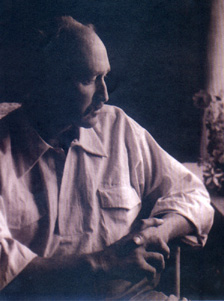 As his dear friend, colleague and playwright once said of him, "He paints as other men must dream, and his visions take him back thousands of years of world subconsciousness. He belongs to no one medium but to all. His is the gentleness of the large man who cannot touch something small for fear of crushing it, yet all subtleties of his nature find expression on canvas." — Henry Miller, 1955.
As his dear friend, colleague and playwright once said of him, "He paints as other men must dream, and his visions take him back thousands of years of world subconsciousness. He belongs to no one medium but to all. His is the gentleness of the large man who cannot touch something small for fear of crushing it, yet all subtleties of his nature find expression on canvas." — Henry Miller, 1955.
For more information on the Rogoway Collection, contact the Lanning Gallery at 520.282.6865 or www.lanninggallery.com

All rights reserved ©
Press Coverage | VentureCapital | Business Development | Venture Opportunities | Resources | Contact Us | Investor Extras | Home